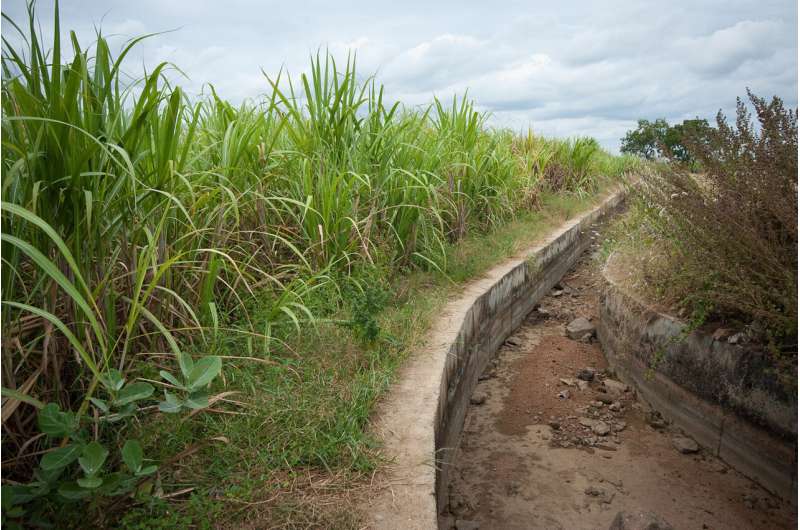Climate-smart rice cultivation system shows promising results

With its extreme weather conditions, climate change poses a threat to rice farming across the world, among other things due to anticipated irrigation water scarcity and escalated labor costs.
Not only that, conventional paddy, where rice is grown by transplanting seedlings in puddled soils, is a major emitter of methane. In Asia alone, these types of rice growing systems are considered the second largest emitter of greenhouse gases. Moreover, they are labor, water and energy intensive, and have a negative effect on soil structure.
"There is a dire need to promote new systemic solutions to promote sustainable and climate-neutral farming systems," says Dr. Udaya Sekhar Nagothu from the Norwegian Institute of Bioeconomy Research. "Shifting to climate neutral and resilient farming systems such as direct seeding of rice can address both climate adaptation and mitigation if implemented in the right way."
Reduced methane emissions in both wet and dry conditions
Dr. Nagothu coordinates Resilience, a collaborative multidisciplinary and multi-actor supported research program, which is currently being implemented in the two states of Odisha and Assam located in the east and northeastern parts of India. Here, the main goal is to improve agricultural productivity, adaptive capacity and livelihoods of smallholders to climate and economic changes.
"In Resilience, our aim is to find ways to increase the climate resilience of Indian smallholders. This can be achieved by implementing sustainable solutions combined with agroecological farming approaches in order to strengthen their food and nutrition security," says Dr. Nagothu.
One of the systems which has been implemented in Resilience's project areas, is direct seeding of rice (DSR) in both wet seeded and dry seeded conditions. The system entails growing a rice crop from rice seeds sown directly in the field, as opposed to transplanting seedlings raised in nurseries customary in traditional rice paddies.
"Both earlier research and our results show a significant reduction in methane emissions from DSR fields under both wet and dry conditions," Dr. Nagothu says. "There are a few challenges though, one of which concerns elevated nitrous oxide emissions. This can be solved by developing proper nitrogen management practices to curtail the losses of reactive nitrogen."
As far as the global warming potential (GWP) of DSR is concerned, the overall net effect of the greenhouse gases emitted decreases by 16–33 percent in comparison to conventional rice farming practice.
Direct seeding of rice has many advantages
As a system, DSR ensures optimal plant density and high-water productivity. In rainfed areas, DSR can reduce climatic risks, thus benefitting smallholders by reducing the risk of market failure by timely management of irrigation and tillage operations, along with reducing the cost of buying these services.
Another major advantage with DSR is the avoidance of transplanting shock, and more biomass overall compared to that of conventional practices.
As far as grain yield is concerned, the findings of Resilience show that it is highest in wet seeded DSR, followed by dry seeded DSR. According to Dr. A. K. Nayak from the National Rice Research Institute in India, the rice yield under DSR increased by approximately 6.7 to 13.3 percent compared to conventional practices in the wet season, and between 6.5 to 11.5 percent in the dry season.
"Taking a modern biotechnological and genetic approach for the development of resource efficient rice varieties can assist in optimizing the DSR yields further," Dr. Nagothu says. "This, together with the development of effective crop management practices for enhancing resource use efficiency, make DSR stand out as a better alternative to conventional transplanted rice."
Good management strategies needed to tackle challenges
In order to cope with the vagaries of climate change, a continuous effort for a resource efficient alternative rice establishment method is needed. In the Resilience project, DSR has proved to be a viable option for climate-smart rice production as it, in addition to being relatively climate-neutral, offers similar and comparable yields to that of conventional, transplanted, puddled rice.
"Efficient management of the limited irrigation water availability for enhancing water use efficiency is, however, a challenging task," Dr. Nagothu says.
Another important aspect to take note of is weeds, as they are one of the major constraints when it comes to limiting grain yield. Site specific integrated nutrient and weed management strategies are needed in order to address yield decline and enhance efficiency under DSR.
These are among the challenges which are currently being addressed by Resilience in order to make the system easier for farmers to adopt. In the time ahead, the project plans to scale up DSR in the case study areas. They will also provide the involved farmers with training, accessibility to good quality seeds, drum seeders, selective herbicides, along with appropriate policy measures and institutional support.
Provided by Norwegian Institute of Bioeconomy Research
















